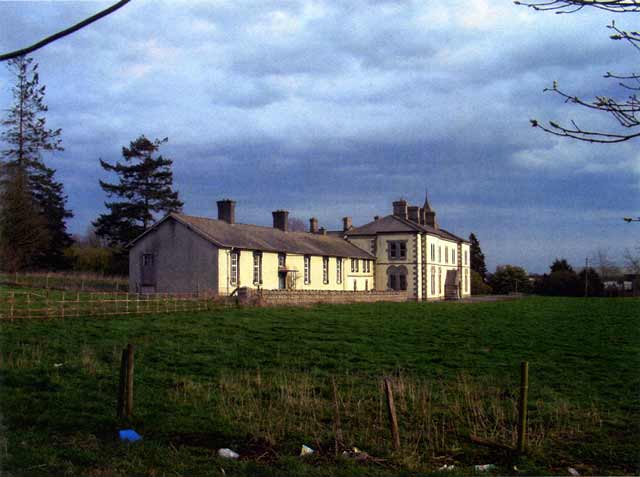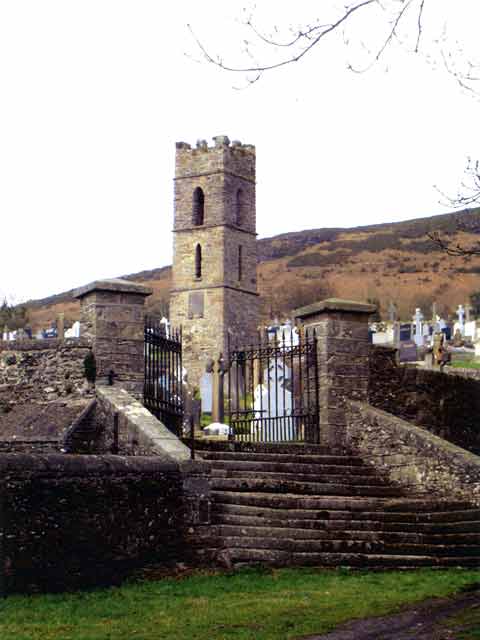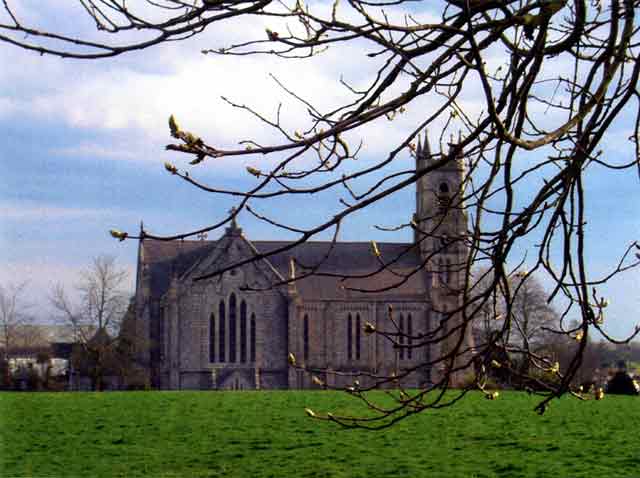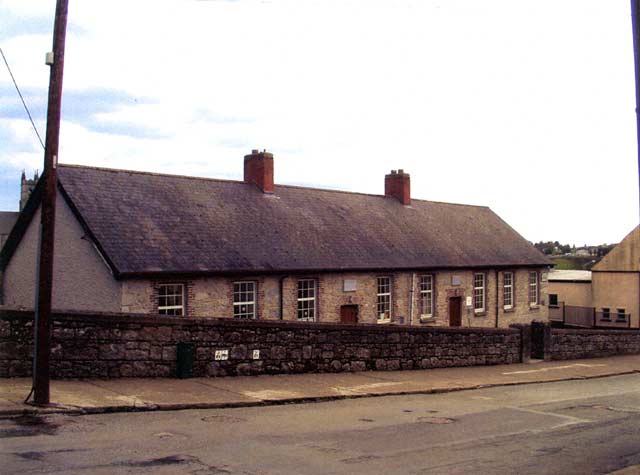
| Index | Previous... | Next... |
Baltinglass is a heritage town, steeped in history. The following is not an inclusive account.
(Seen in the left of the picture below)
Dermot McMurrough, King of Leinster, founded the site in 1148. It housed the Cistercian order until 1537. They turned what was an area of 'scrubland' into viable farming land beginning modern agriculture in the area. Due to the close proximity to the river, markets nearby began to develop. The monks studied farming and trade as well as religion.
The abbot of Baltinglass was lord over the abbots of Jerpoint, Ossory, Abbey Mahon, west Cork, Monasterevin, Co Kildare and Abbeyleix. His rank was Mitred Abbot, so higher than the Bishop and later became a lord of parliament.
In 1526 the dissolution of fourteen religious houses was ordered by the Irish parliament, Baltinglass was one.

(seen in the right of the picture above)
The Church of Ireland stands in the middle of the Abbey ruins. Built in 1883 with the Rectory following on the site of the Abbot's castle in 1884.
Used as a setting in the film Evelyn, staring Pierce Brosnan.

This stands in the graveyard alone. The penal Laws did not allow the bell to be attached to a church. It was used until 1937.

The Roman Catholic Church was planned in 1892 following the "Catholic Emancipation". Building started in 1845, delayed by the hardship suffered during the famine it was completed in 1895.

Surrounding the passage tomb on the summit of Baltinglass Hill is a double-ramparted hill fort known as Rathcoran.
The name by which a cause célèbre of 1950 was known in the Irish media. The dispute was caused by the action of a parish-pump politician, James Everett (1890-1967) labour T.D. for Wicklow. Everett was appointed minister for Posts and Telegraphs in the inter-party government that took office in 1948. In 1950, ignoring the rights of the incumbent family, the Cookes, he appointed one of his own supporters, Michael Farrell, as postmaster of the sub-post office in the village of Baltinglass, Co. Wicklow. The Cooke family protested, and many politicians were appalled by such marked jobbery. But after Labour's coalition partners, Clann Na Poblacht, whose election plans included opposition to corruption failed to demand justice from Everett, it was the people of Baltinglass themselves who took up cudgels in the Battle of Baltinglass. They arranged to boycott the general store that Michael Farrell also owned in the village and the following year 1951 Farrell resigned his position as postmaster. An anonymous contemporary balled describes the battle...
"There were bremagums and stem-guns and whippet tanks galore, As the battle raged up and down from pub to gen'ral store"
Taken from Brewer's Dictionary of Irish Phrase and Fable. Sean McMahon & Jo O'Donoghue P.59.
The branch railway line passed through Baltinglass from Sallins, Co. Kildare to Tullow, Co. Carlow. Built by the Great Southern and Western rail company and opened in Baltinglass in 1885 and closed in 1959.
Much has been written about these linking them to certainly the Iron Age and likely the Bronze Age.
Built in early 1930's by Wicklow VEC to house the vocational school. Until the early 1960's Baltinglass was the only West Wicklow town with post primary education. In 1952 a bus service ran children from surrounding areas to the school.
On Chapel Hill, this was the old boys' school. Many local community groups use this parish-owned building.
The Department of Education funds the outdoor education centre. The refurbishment and renovation of the building (which was the old VEC school) was funded by County Wicklow Vocational Committee and FAS. It provided outdoor education thus promoting personal development and educational development of children at primary and post primary level.
Participated in the 1798 rebellion, he was a Presbyterian but attended mass with Michael Dwyer. This group of rebels operated in West Wicklow, mostly in the Glen of Imall, 7 or 8 miles north east of Baltinglass. MacAllister was fatally wounded while Michael Dwyer avoided capture for about five years, when he gave himself up and was sent to Australia to start a new life with his family.
Sam MacAllister is buried in Kilranelagh graveyard, which is included in a forest and archaeological trail from the educational resource centre.
The centre offers a range of educational, employment and recreational support for people with learning disabilities from Baltinglass and surrounding areas. The centre is run by KARE, a voluntary disability organisation based in Newbridge, Co. Kildare. KARE also provides services to people with learning disabilities at centres in Tinahely and Blessington, Co. Wicklow.
The Lalor Centre supports 40 individuals with learning disability from Baltinglass and surrounding areas. A key element of KARE philosophy is to support the integration of people with learning disabilities into community life. This is facilitated through accessing educational opportunities for people with learning disabilities in their own community, identifying supported employment opportunities in close proximity to where individuals live and encouraging independent living by supporting individuals to access transport and other services.
KARE: Lalor Centre Baltinglass.
Even though major successes came to Baltinglass in comparatively recent years - their first senior championship was won in 1958 - Baltinglass is, in fact one of the oldest clubs in Wicklow.
On St. Stephens Day 1886, Matt Byrne represented Baltinglass (then Maurice Davins) at the first Co. Wicklow Convention held in the Town Hall Wicklow. Matt became County Registrar, remained active in the GAA for over fifty years and was justly esteemed as the Father of the Gaels.
But, the first seeds were sown in Woodfield, just outside Baltinglass on the Kiltegan parish side. This Woodfield team was in fact the first in West Wicklow, organised by a Denis Murphy who died in New York in the early thirties. While Woodfield formed in October 1885, they did not play a game until January 1886. Prominent names in those days were Pat Furlong, Denis Murphy, John Finn, Jim Fluskey, Terry Reilly, Anthony Ovington. Later that year, in December, Matt Byrne captained a Baltinglass combination against a Pat Furlong captained Rathdangan team, Baltinglass were reputed to be better trained and won easily. On March 18,1888, they beat Hacketstown by the remarkable total of 6-6 to nil.
In 1887 and 1888 political rifts hindered GAA unity. But in the 1889 championships Baltinglass Maurice Davins eclipsed Hollywood and Ballyknockan 98's beat Rathdangan. A west final between Baltinglass and Ballyknockan had to be played twice, Ballyknockan winning eventually. That particular west final between the Baltinglass Maurice Davins and the Ballyknockan 98's was famous for its commitment and courage, essential ingredients for success. In more modern language, it was a hard game, the kind of clash which was recalled by old-timers through many decades. Owing to the infancy of the association and the number of teams participating, as well as transport difficulties, championships were loosely organised and long drawn-out. Baltinglass, so far west of the Wicklow hills, played against clubs from counties Kildare and Carlow for convenience. Matt Byrne and Pat Furlong continued to keep Baltinglass/Rathdangan flags flying through periodic games.
The unfortunate Parnell split did not help matters just when the GAA had developed into a truly national movement. Nowhere, of course, was the bitterness and reaction felt so keenly and destructively as in his native county. The GAA was practically forgotten in the political turmoil as can be gauged from the fact that only three counties sent representatives to the All-Ireland Convention of 1893 in Thurles.
Baltinglass disappeared from Wicklow inter-club activity for some years. In the 1880s, what organised games there were seemed to be mainly in the east of the county.
In 1898 the Dublin-Wicklowmen's Association, under the chairmanship of Hugh MacCarthy erected three monuments, one of which was in Baltinglass, to McAllister. Baltinglass was not represented at the 1898 Convention. In the period 1899-1901, games slumped badly in the county, though some tournaments were held, but Wicklow took no part in the inter-county championships and consequently were penalised by the Central Council. In 1901 only two teams, Wicklow and Rathdrum, were affiliated in the county. In 1902, The McAllister Memorial Tournament was organised in Baltinglass and had teams from Kildare and Carlow participating, as well as Wicklow. The success of this tournament was due to the great organisation of Martin Gleeson. Baltinglass did affiliate a team in 1902.
Hurling was introduced into Co. Wicklow this year with the legendary Matt Byrne getting the sport going in Baltinglasss. But the first hurling championship was not played until 1903 when Baltinglass lost in the final to Wicklow. This game was played in a snow-storm at Annacurra, a John Fleming refereeing and the final score was 1-6 to 0-1.
Par Furlong, the man prominent in establishing the GAA in Woodfield and Rathdangan writes of the transport difficulties encountered by players in those days. He says "players were lucky to count on three or four days to carry them to the venue. Often they walked fifteen miles, played a match, danced for hours, and walked home again. When Rathdangan could bring Johnny Murray, the Irish dancer, they felt no distance. I unhesitatingly say there was more sport in those days of the drays and Irish dancing than in our fashionable days of motors and waltzes."
There is a game between Baltinglass, the winners, and Dunlavin recorded in 1904 in Miss Hargrove's field at Newtownsaunders which was used as a sports field. In fact the game of cricket was played in this field.
It would seem that in the early part of the century, participation by Baltinglass in actual competition continued to be spasmodic. Wicklow football being dominated by eastern clubs like Rathnew, Avondale and Wicklow, Baltinglass continued to play most of their football against teams from Carlow and Kildare. Obviously in the pre-motor days, travelling was a problem, so it is sensible that nearby clubs from contiguous counties would be more easily accessible, in view of the geographic position of Baltinglass.
Matt Byrne taught third and fourth classes in Baltinglass National School on Chapel Hill and my vivid recollection of him originates as his pupil and nephew. Of medium stature, wit, white hair, moustache, spectacles, he was to my mind, not unlike Arthur Griffith in appearance. To some he may have appeared distant and even dour but, if so it was but the outward symptom of a self-disciplined man of deep thought. To his family and those who know him intimately there was underneath a genial, generous and entertaining character.
In this Centenary Book he has been given a deserved place because of his abiding interest and activity in the Gaelic Athletic Association but there was a many other sided aspect of this quiet unobtrusive man. Fond of swimming, he joined us in the fresh cool Slaney waters of the long summer's evenings. A great walker, he loved to climb the hill which overlooks Baltinglass, on outlet for his inclination toward solitude, despite his very active life. His research and interest in archaeology played an important part in the discovery in 1936 of one of the most famous cairns of burying places in Ireland on the Rathcoran Pinnacle of the Hill.
But apart altogether from the sporting side of life, he was, I think, a man before his time in what would now be regarded as community or social activity for the common good. He, of course, loved teaching, and during the spell of almost forty years in theatre profession, he always has a helpful eye for students searching for betterment or a career. He acquired a knowledge of the Irish language late in life and after retirement in 1925 he continued a deep interest in education, playing an active part in the establishment of the first technical school courses in Baltinglass, A member of the old age pension committee and of the local hospital group, the last war found him a willing helper in the then emergency and organiser of the local branch of the Red Cross. As a journalist of the provincial papers in the area his pen propagated the interests of west Wicklow.
A man of deep religious faith, Matt Byrne, closely identified with St. Joseph's Church and the parish of Baltinglass and gave unstinted assistance to its fear Pastors and indeed. Prefiguring the development of our own day, he participated publicly in the liturgy - clearly I recall his leading the church recital of the October rosary and his honoured past in the great forty hours processions of the time.
But, of course, in this centenary publication we are primarily concerned with Matt Byrne's passionate preoccupation with the Gaelic Athletic Association. Known to have been a good footballer in his youth, he was amongst the founders of the famous Maurice Davin Baltinglass club in 1889. From the year 1886 when in his teens he attended his first Wicklow County Convention, he continues as a member of the County Board to the end of his days, being chosen year after year as the registrar and representative on the Leinster and Central Councils. He had a particular leaning toward the grand game of handball and was chairman of its association. Eventually as was befitted, he was styled the "Grand-old-man" of the G.A.A. and the association honoured him be dedicating the "O'Byrne Cup" to his memory. The deep tie with the G.A.A. was perpetuated by his son "young Matt Byrne" who played on the Wicklow County team and who reached All-Ireland status in the Handball code, but who tragically died young.
In Matt Byrne's life and all his activities which entailed continuous absence from home at matches, meetings and functions and which meant endless visitors, including top personalities of the G.A.A. to Chapel Hill, his path was made smooth by the attention of his devoted and loving wife Kate (nee Hourahaine) who hailed from West Cork. She was a refined and gentle soul of real personal charm.
The place of Matt Byrne in the life of Baltinglass, Wicklow, and indeed of the Nation was evidenced by the widespread attendance and tributes at his obsequies when he passed away in 1947. He was, I think, one of those of whom it could be fittingly written - "Ni bheidh a leitheid ann aris".
Written by Matthew Byrne B.A. July 1984
The Baltinglass of my youth differed little from any other town or village in West Wicklow. If you travelled in the Kiltegan Road on a Sunday evening - or any evening for that matter _ you would see a group of young men kicking a football, in the rather aimless and haphazard manner of the day - in Jones's field beside the Hospital, or later in Dan Keogh's field by the river bank - the outward signs that a Football Club of some sort existed in the town.
If you read the local newspapers however you would be aware that the real seat of football power in the area was situated two miles out the Dublin road in Tuckmill where the McDonnells, the Doodys and the Doyles had strung together a useful team and had found the championship-winning formula.
The GAA had just celebrated its Golden Jubilee year. In the first fifty years the record of the Baltinglass Club was much the same as any other club in the area. They did play a bit more hurling and had a Senior Championship in that code to their credit; they had produced a Champion Handballler in Matt Byrne but in football the real breakthrough was still far away.
The club struggled for survival through the dark days of the 30s - Dark in more ways that one. The economic War bit hard in a town like Baltinglass, depending as it did on the agricultural community for survival. Emigration was rampant. For the few luckily enough to find jobs at home, survival and not sport was the priority.
What then transformed a very ordinary run-of-the-mill Club into the super force we know today? The first breakthrough came in the form of a MFC in 1940 - a victory that was far more important than anyone realised at the time. It came as reward and encouragement for mentors like Michael Cahill who had ploughed a lone furrow for so long. More important it signposted the way forward which was through underage ranks.
A new generation was emerging to take charge of affairs in the club. Jim Brophy became secretary in 1941 and by the time he vacated the post 10 years later Baltinglass was well on its way to becoming a top class club -even if they still had not got a top-class team,
The next milestone in the history was the four-in-a-row minor team of the early 50s. From that golden era came the players such as Ken Browne, the Scotts, the Nolans, the Rodgers, the Mortons and the Connells to blaze the trail to senior glory.
But if lasting glory was to be attained more than talented players would be needed. After all, other clubs - Ashford is one that springs to mind - had enjoyed remarkable success at under-age level without any lasting benefit. The club leaders at the time had to be men of great vision. They resisted the temptation to put winning Championships above all else and instead devoted time and energy and money to buying, and developing their playing field, so ensuring a permanent home and guaranteeing the future of the Club.
Peter Brophy was the prime mover at the time and has around him men like Sean OToole, Jim Byrne, Godfrey Timmins, Johnny Kenny, Denis Patterson, Ned and Peter Nolan.
It would be all too easy to lose sight of the part played by the Vocational School in the progress of Gaelic Games in the town and the area at large.
The Principal teacher Ben Hooper may not rank in history as one of the great, active promoters of Gaelic Games but it is certain that the GAA in Baltinglass and West Wicklow owe him more than they can ever hope to repay. He was the prime motivator in setting up the first school transport system in the county and brought students from as far away as Blessington and Kilbride to the Baltinglass School. It was there that many a boy learned - among other things - the basics of football.
It may also help to explain why you find names from as far away as Dunlavin on Championship winning teams from Baltinglass in the 50s.
By Peter Keogh, Chairman, Co. Wicklow G.A.A. Board
In the summer of 2003 Ireland hosted The Special Olympics World Summer Games and we in Baltinglass played our part in their success. Our town and surrounding areas showed great friendship, warmth and fenerosity towards the Seychelles team.
In June 2003 as the Host Town Programme was drawing to a close, some of the members of the Committee set about harnessing this enthusiasm and goodwill. More members were encouraged to join and thus formed the Baltinglass Cultural Committee. It was decided to hold a cultural day annually to celebrate the talent of all the people in the area. The stage was set for many local groups to display their talents. All age groups are invited to participate from toddlers to senior citizens.
The location of this annual event is the cobbled area in front of the courthouse, where we erect a stage, provide seating and create a very picturesque arena for a mid-summer afternoon's enjoyment.
Each year there is also a local heritage walk under the guidance of the West Wicklow Historical Society, a fancy dress parade for our younger folk, face painting, street entertainers, mineral stalls, popcorn stands. The local Foróige Club helped with these stalls. The Tallaght Youth Band attended.
It is hoped a Cultural Weekend with a full two-day programme of activities.
| Index | Previous... | Next... |